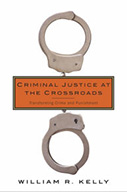Criminal Justice At The Crossroads: Transforming Crime And Punishment

Author: William R. Kelly
Publisher: New York: Columbia University Press, 2015. 424p.
Reviewer: Rebecca Kunkel | March 2017
Were it not for the recent authoritarian turn in American politics, Criminal Justice at the Crossroads might have been described as a playbook for a new bipartisan consensus on criminal justice. This book is primarily devoted to showing that sentencing reforms grounded in empirical evidence can improve public safety. It is from this perspective that Kelly criticizes mass incarceration: he argues that implementing evidence-based sentencing practices can reduce crime rates at less expense than the current system premised on harsh punishments. As he emphasizes in the book’s final chapter, this call to get “smart on crime” echoes recent statements by everyone from Obama-era attorney general Eric Holder to Reagan-era attorney general Edwin Meese.
Memories of the old bipartisan consensus on criminal justice (you know—the one that produced mass incarceration to begin with) might have, for a time, been expected to do some of the work of tempering enthusiasm for this convergence of opinion. Unfortunately, from today’s vantage point, this is a book that appears to be articulating one side of an intensifying ideological division between a technocratic center and autocratic right. Within this division, technocratic centrism has been newly cast in the role of the ego charged with suppressing a nascent authoritarian id. This is a role that the centrist position is ill-equipped to play, as an examination of the argument advanced in this book reveals. The argument against mass incarceration that proceeds not from concern with its implications for justice, equality, or democracy, but from the assumption that criminal justice reform should improve the efficiencies of the current system is prone to reproducing its repressions, which differ only in degree from those of the regime it is intended to “recalibrate.”
The book opens with a broad introduction to U.S. criminal justice policy beginning in the 1960’s. Kelly marks this decade as a pivotal time, as increases in violent crime, perceptions of the Warren Court’s criminal procedure jurisprudence as coddling criminals, and social unrest related to the anti-war and civil rights movements converged and were effectively exploited by Nixon’s 1968 presidential campaign. Following on this success, “tough on crime” posturing became a hallmark of national politics in the ensuing decades, and served as the driving force behind much contemporary criminal justice policy. Kelly associates this “tough on crime” ideology with the creation of several policies that serve as his focal point in explaining the incarceration boom: sentencing guidelines that make frequent use of mandatory minimums, truth in sentencing laws aimed at preventing early release from prison, and expansion and aggressive enforcement of the drug laws. Within the framework of utilitarian theories of punishment, Kelly argues that stricter criminal justice policies have not reduced crime, particularly in light of mounting evidence that incarceration actually defeats the aim of specific deterrence by encouraging recidivism.
The remainder of the book is devoted to constructing an ostensibly non-ideological alternative to the “get tough” philosophy and the associated rise in incarceration rates. The material for this project is drawn from empirical studies of individual behavior modification as a means of crime prevention. Chapter Three serves as a broad introduction to this approach, considering nine general evidence-based “best practices” and the institutional prerequisites required to implement them. Chapter Four discusses sentencing policy on a broader scale, with a particular focus on developing evidence-based alternatives to more punitive sentencing policies such as mandatory minimums. Chapters Five and Six consider the literature on major extant alternatives to incarceration: problem-solving courts such as drug and mental health courts, and parole and probation. While each of these chapters reviews the literature on a slightly different aspect of sentencing, the recommendations in each chapter strike many of the same notes: the ability to accomplish recidivism reduction will be largely dependent on inculcating deference to experts in the creation and application of evidence based diagnostic tools that assess the best path for treating each individual defendant. In order to accomplish this goal, would-be criminal justice reformers must generate “buy in” from various “stakeholders,” identified as the people who presently hold roles of power and authority in the criminal justice system: police; prosecutors; judges; court supervision officers; and even, at times, defense attorneys.
Chapter Seven, which deals with drug policy, shifts the focus slightly from the almost exclusive preoccupation with sentencing, as it includes some consideration of proposals that would target the substantive definition of crime by decriminalizing drug possession. Despite acknowledging that the worst aspect of the drug trade—the violence associated with it—is exacerbated by criminalization, the chapter avoids weighing in on the ultimate question of legalizing any but small amounts of marijuana as politically unfeasible.
The last substantive chapter is devoted to demonstrating the cost-effectiveness of various sentencing practices recommended in previous sections. The literature review here leads Kelly to conclude that various practices recommended as effective means of preventing future crime are also generally lower in cost than incarceration.
As an argument against mass incarceration, the “smart/cost-effective” rhetoric may have some practical use persuading decision-makers who believe in punitive sentencing for its own sake to take a less punitive approach. For this reason criminal defense lawyers may also find the literature reviews useful, as they summarize a number of studies that can be cited in support of the benefits of reduced or non-custodial sentences.
However, despite the assertion at several points that implementing evidence based alternatives will require major cultural and attitudinal shifts at all levels of the criminal justice system, as well as major changes to the basic allocation of criminal justice funding, the book’s proposal for reform remains a profoundly conservative one. Kelly justifies the narrow focus on behavior modification after the point at which a crime has been charged: “absent the elimination of poverty, mental illness, inadequate public education, physical health problems, homelessness, and so on, the American justice system will continue to be placed in the position of dealing with the failures of these institutions” (p. 4). This is an oblique reference to the possibility that wider political and economic forces influence whether crimes are committed, investigated, and prosecuted; which simultaneously dismisses an agenda focused on reducing incarceration through reform of this underlying structure as impossibly utopian fantasy.
The preoccupation with individual behavioral correction—what Marie Gottschalk (2015) calls the 3-R solution focusing on recidivism, reentry, and justice reinvestment–“stress(es) individual solutions and personal responsibility while slighting the responsibilities that the state and society have to the country’s most disadvantaged citizens”(Gottschalk p. 79). While moral judgment and condemnation have always played a prominent role in advancing a law enforcement agenda, these ideas have over the past four decades come to be extensively deployed in attacks on social expenditure under the guise of welfare reform. Aggressive policing of the poor and racial minorities has helped to construct an underclass mythology that continues to provide the moralizing undercurrent to many contemporary discussions of public policy (Reed, 2000). Law enforcement practices, bolstered by ideas about crime and personal responsibility have, in this regard, had an important role to play in quite literally enforcing neoliberal policies responsible for weakening the institutions—schools, housing, public health programs, welfare, labor protections, public sector employment—that might serve as bulwarks against individuals entering the criminal justice system to begin with.
To recommend investment in social welfare programs in a way that is tailored to promote individual behavior modification after the point at which an arrest has been made is to leave this ideological function of criminality intact. Presenting lower-cost alternatives that leave these ideas unquestioned only serves to shore up the overwhelming power of the criminal justice system in the face of questions raised by the financial costs associated with mass incarceration. Even if we assume that the proposals in this book will be successful at securing modest reductions in the incarceration rate over time, its insistence on continuing and intensifying the role of criminal justice system in rationing social services remains deeply problematic. The criminal justice system is an institution irreducibly committed to sorting a law abiding “us” from an immoral “them” appropriately subject to loss of freedom and full status as members of the polity. Despite its soft power window dressing, a program for criminal justice reform that remains narrowly focused on reforming individuals continues to legitimize the use of this underlying coercion to maintain extant power relations.
References
Gottschalk, Marie. (2015). Caught: The Prison State and the Lockdown of American Politics. Princeton and Oxford: Princeton University Press.
Reed, Adolph. (2000). “The Underclass Myth.” In Class Notes: Posing as Politics and Other Thoughts on the American Scene. New York: The New Press.


